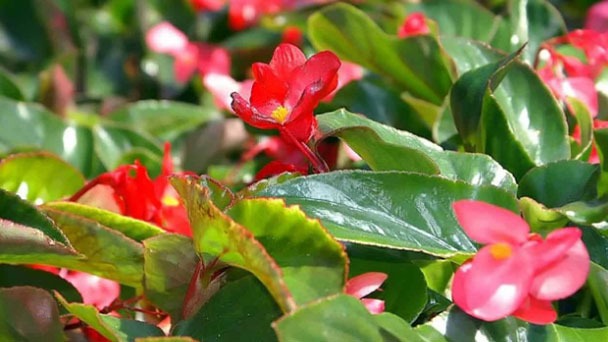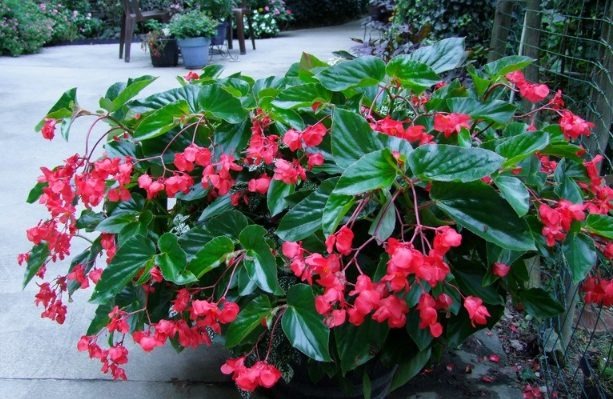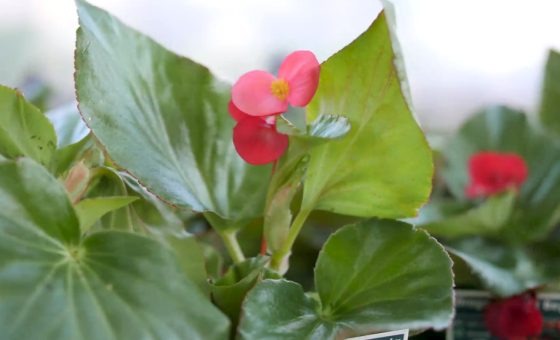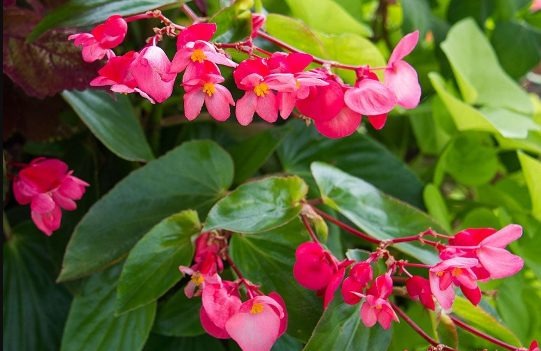Dragon Wing Begonia Plant - Care and Propagation Tips
Written by Ivy
Jan 21 2023

Angelwing Begonias come in different varieties, including Dragon Wing Begonias. With enough water and a location that offers some shade to full shade, these plants thrive in warm climates and are very heat tolerant. When given proper care, Dragon Wing Begonias will fill their containers to the brim with flowers all summer long!
What is Dragon Wing Begonia Plant?
Now, keep in mind that while both the angel wing begonia and cane begonia are hybrid species derived from two different plants, they should not be confused. The scientific name for this begonia is begonia x hybrida "Dragon Wings."'
It is also heat tolerant and does well in humid environments. You can anticipate pink, white, or red flowers in the spring and summer depending on the type of dragon wing begonia you have. The leafy tropical plant grows with the shape of wings and looks stunning in hanging baskets.
The dragon wing is a vigorous grower, and it can get up to two feet tall and spread out wide, so take that into consideration as a word of caution. Additionally, you could put them in a container and set it up on the patio. Most importantly, of all the species, this one is the easiest to grow indoors.

Dragon Wing Begonia Care
Size & Growth
While growing quickly, dragon wing begonias don't get very tall; their maximum height is only about 2 feet.
This plant is known for its shiny and dark green attractive leaves, which are wing-shaped and long, often growing up to 8" inches.
It typically takes the form of a bushy mound and is very simple to grow. Ample space is needed for the growth of this begonia.
Flowering and Fragrance
From late spring to fall (until the start of frost season), the dragon red wing begonia produces clusters of small tuberous (bell-like), scarlet-red flowers, adding to the plant's allure.
More factors contributing to the dragon wing begonia's popularity as a garden plant include its lengthy blooming period and its prolific production of showy flowers, even in the hottest summers.
Light & Temperature
Because this hybrid begonia species can withstand extreme heat, it blooms and colors landscapes even when the weather is scorching.
It is winter hardy to USDA hardiness zones 9 to 11, but it cannot tolerate extreme cold.
It is advised to dig up the dragon wing begonias before the start of the frost season or bring the containers indoors when grown in other USDA zones.
Throughout the winter, keep the plants dormant and in a cool, dry location.
Despite the cane begonia's ability to tolerate both full sun and shade and its tolerance of both, it is advised to give it some partial shade, especially during extremely hot weather.
A location with some afternoon shade, good air circulation, and protection from strong winds is ideal for growing the cane begonia variety.
Similar to how the red wing begonia can tolerate full sun, it can also tolerate complete shade, but flowering will be affected.
When exposed to bright, part-sun light all year long, the hybrid Dragon wing grows the best and sets more flowers.
Watering and Feeding
In order to keep the soil moist, water it sufficiently and frequently enough to satisfy the preferences of the begonia "Dragon Wing Red."
However, be careful not to overwater.
Less watering is preferable to more watering when it comes to caring for dragon red wing begonias because they can tolerate some drought.
The rule of thumb for watering dragon begonias is to let the top 2″ – 3" inches of soil get dry between waterings.
Feed your dragon begonia once every two weeks during the spring and summer months with a balanced liquid fertilizer that has been diluted (by half).
In the fall and winter, fertilizing should only be done once per month.
Always fertilize plants when their soil is moist to prevent fertilizer burn.
Soil & Transplanting
Red begonias do best in soil that is rich, light, moist, and well-draining.
The best soil types for growing the dragon wing are loamy and sandy soils.
As was already mentioned, the dragon likes moist soil better than soggy soil.
Therefore, make sure the soil has good drainage in addition to avoiding overwatering.
The plant prefers acidic or neutral pH soil in terms of soil chemistry.
Humidity
Because they are tropical plants, Dragon Wing Begonias need humidity levels of between 50 and 60 percent. To keep the humidity levels in your home at a suitable level if it is dry, you can purchase a humidifier. However, misting your plant's leaves should be avoided as it can cause fungus problems. To reduce issues with pests and disease, Dragon Wing Begonias should also have good airflow and ventilation.
Grooming and Maintenance
Dragon wing maintenance is simple because they are not only simple to grow but also trouble-free.
Not even deadheading is required for maintenance or grooming.
Propagating Dragon Wing Begonias
The sterile seeds produced by the begonia dragon wing are produced.
Stem cuttings are the most effective and convenient method of spreading Begonia "Dragon Wing Red".
Take about 3" to 4" inches long tip cuttings from the non-flowering stems in spring or early summer and root them in moist sterile potting mix.
Another way to spread dragon wings is through division.
But you need multi-stemmed plants for this.
Look at each of your dragon wing begonias' bases, then pick the one with the most base stems.
Dig up the plant, separate the stems, and plant each one separately.

How to Prune for the Best Results
These plants require no pruning at all, and it couldn't be simpler. Simply cut the stems off where they meet other stems, at the nodes.
This kind of pruning is beneficial to keep the plant's size under control and compact. If you don't do this, the plant will keep growing until it reaches its full size and become a little unruly, especially if you're using them in pots on a porch.
If you plant them in your gardens, pruning is not necessary unless you need to maintain a specific size for the needs of your garden and the plants nearby.
The timing of the pruning is irrelevant. When you feel it's necessary to achieve the desired look during the growing season, do it. Plant won't be harmed by it. It will only be able to produce new growth as a result, and you'll notice that it will keep expanding quickly.
You should take into account their size once they have grown larger if you are planting them in gardens. As you would with small shrubs, space them out and plan on them expanding to fill the area. Remember, however, that that area of your garden will be vacant during the off-season if they are an annual and die after the first frost where you live.
They make a wonderful plant for hanging baskets placed on a deck or front porch that is shaded.] because of their cascading nature. Most of the time, they will completely fill the basket; therefore, no additional plants are required.
These plants would be a great choice if your property has many shaded areas. On the other hand, if your home and its landscaping are mostly in direct sunlight, you might want to consider other plants.
Repotting Dragon Wing Begonia
Dragon Wing Begonias thrive when rootbound because of their fibrous roots. So, only use a pot that is one size larger when you repot your plant in the spring every year or two.
Dragon Wing Pest Or Diseases
Mealybug and whitefly pest infestations can affect wing begonias.
Insects that chew on plants, root rot from overwatering, and powdery mildew can occasionally affect it, but they rarely get out of hand.
Overwatering and planting in poorly draining soil should be avoided because wet soil can cause root rot.
Although it repels deer and rabbits, red wing begonia attracts hummingbirds.
Dragon Wing Begonia Uses
The dragon begonia is a popular plant in gardens, parks, and homes because it is simple to grow, requires little care, produces stunning flower clusters, colorful blossoms, and blooms for a long time.
They can be planted just about anywhere, but they look especially beautiful when grown in beds and borders, pergolas, patios, window boxes, and hanging baskets.
Is the Dragon Wing Begonia An Annual Or Perennial?
The dragon wing begonia may be a perennial or an annual depending on your growing zone, like many other plants.
Because it prefers warmth, this plant cannot endure cold temperatures. As a result, only zones 10 and 11 will see it return. It will perish following the first frost in all other zones. As a result, it would be annual.
Since the majority of people in the country reside in zones other than 10–11, most people consider it to be an annual, necessitating yearly replanting or storage indoors during the winter.
Although dragon wing begonias can be overwintered outdoors in theory, is it actually worth the trouble?
Finding the ideal location is the first step; ideally, it should be near a window that receives morning sunlight.
To maximize your chances of success, bring it inside at a temperature that is nearly identical to the outside temperature. Warmer rooms in the winter tend to be dry, and plants prefer humid environments, so cooler rooms are generally preferable.
Thirdly, and most importantly, if you manage to get it to bloom indoors just like it does outdoors, you will almost daily find flower fragments on your carpet or floor. Do you think it's worthwhile for you to vacuum these flower peddles up? It's not worthwhile to us. Every year, we replace them. For you, it might be.

Where You Should Plant Dragon Wing Begonias
In complete shade or some sunlight, dragon wing begonias thrive. Make sure to place them in a suitable location because they dislike the intense midday sun.
We've grown them in pots on our front porch's roof out of the direct sun and in wooded gardens with filtered sunlight. For us, they have unquestionably prospered in both of these places.
They make wonderful additions to hanging basket arrangements on decks that are shaded or placed on front porches.
These plants would be a great choice if your property has many shaded areas. On the other hand, you might want to consider other plants if your home and its landscapes are mostly in full sun.
Conclusion
Dragon wing begonias are an excellent option for you if you want to have plants that bloom with vibrant flowers and you have some shady areas. A lush indoor plant with bell-shaped, bright red or pink flowers is the Dragon Wing Begonia. This hybrid tropical beauty has pointed leaves and fibrous roots, making it ideal for both indoor and outdoor environments.
Latest Updated
- Benefits of Bugleweed - 7 Science-backed Health Benefits
- Bugleweed Dangers & Side Effects - Is It Poisonous?
- How to Plant Evergreen Trees - What You Should Know
- When to Plant Evergreens - Grow Guide for Evergreen Trees
- 12 Wonderful Evergreen Shrubs for Your Garden
- 12 Popular Evergreen Plants with Pictures for Beginners
- When And How To Prune A Lilac Bush Like a Pro
- How to Grow & Care for Lilac Vine (Hardenbergia Violacea)
- Japanese Lilac Tree (Syringa Reticulata) Care & Propagation Guide
- Shumard Oak Pros and Cons - What to Know
Popular Articles
- Winter maintenance of Antirrhinum Majus
- How to Grow Terminalia Mantaly Tree
- How to Grow and Care for Crossostephium Chinense
- How to grow Antirrhinum Majus in spring
- Peristeria Elata (Dove Orchid) Profile: Info & Care Guide
- Underwatered Snake Plant (Sansevieria Trifasciata) - Signs And How To Fix
- How to Care for Brazilian Jasmine Plant (Mandevilla Sanderi)
- How to Grow & Care for Graptopetalum Purple Delight in Summer
- Rosa Chinensis (China Rose): Plant Growing & Care Tips
- How to Care for Baby Sun Rose (Aptenia Cordifolia)